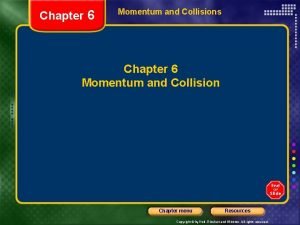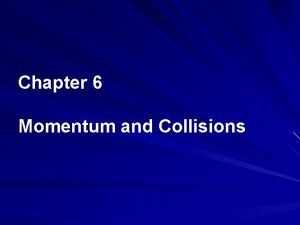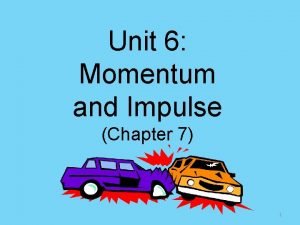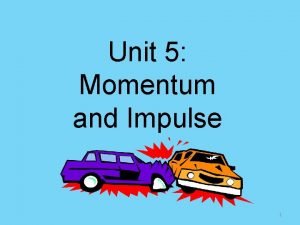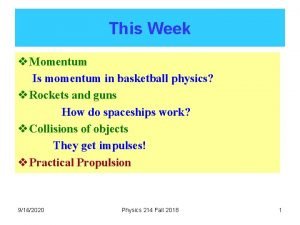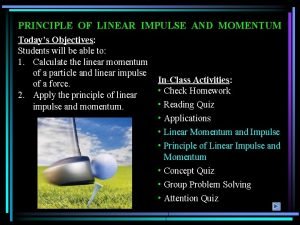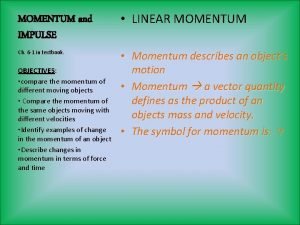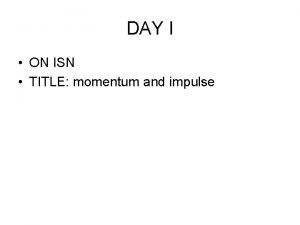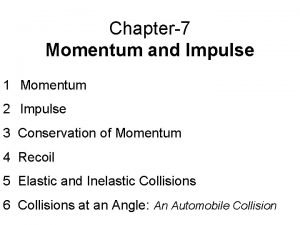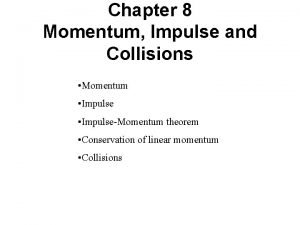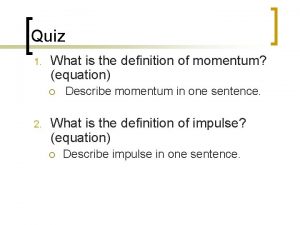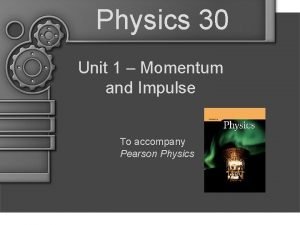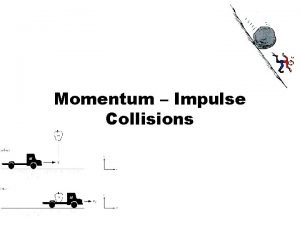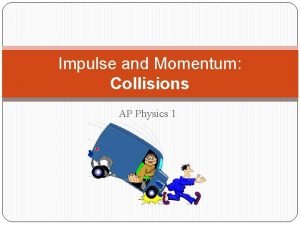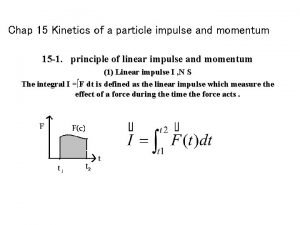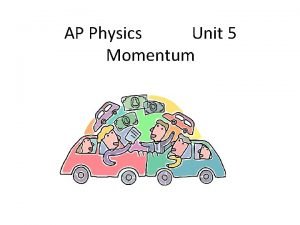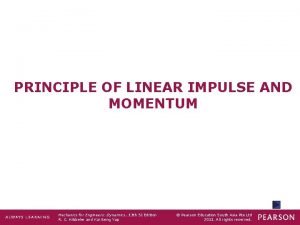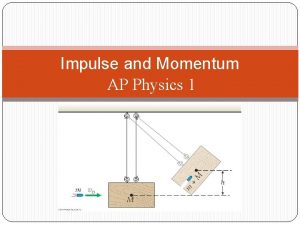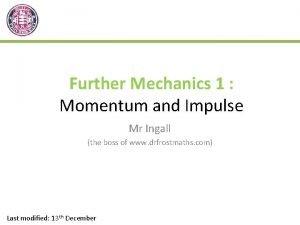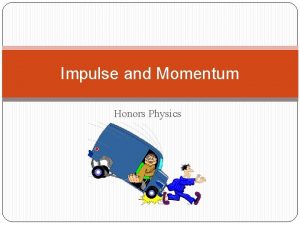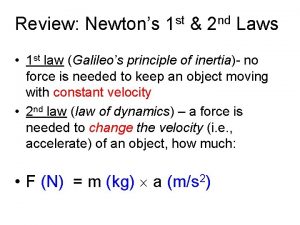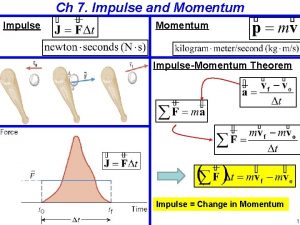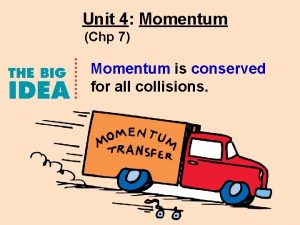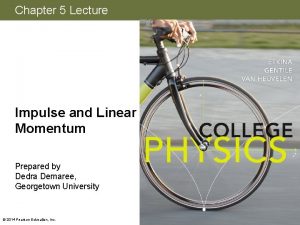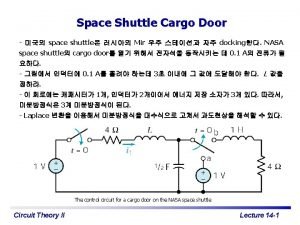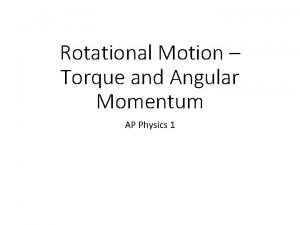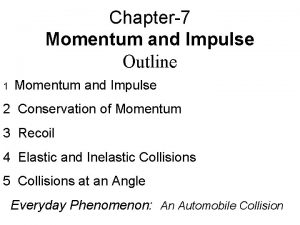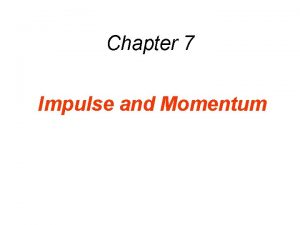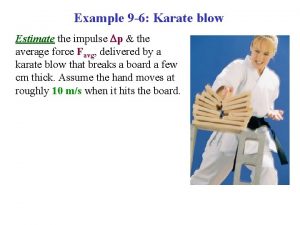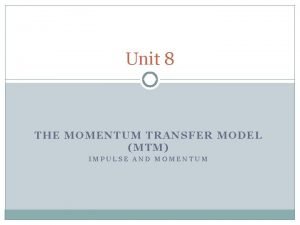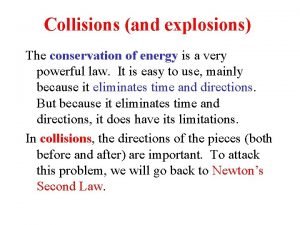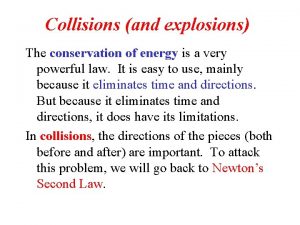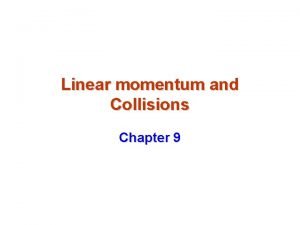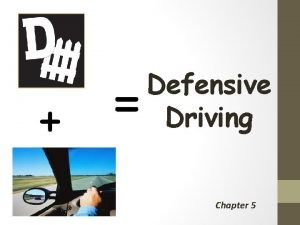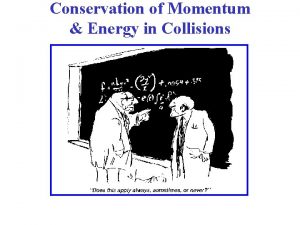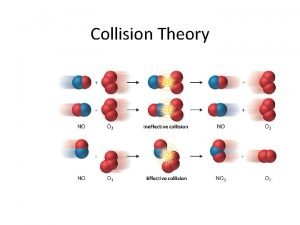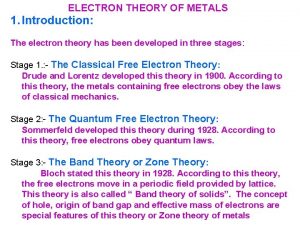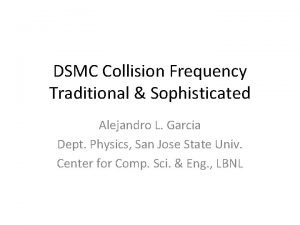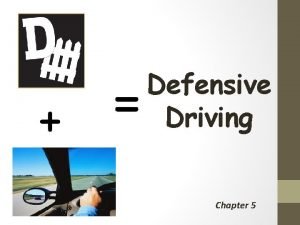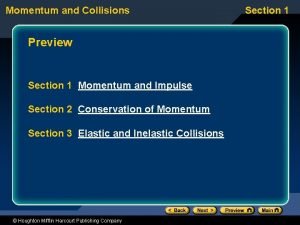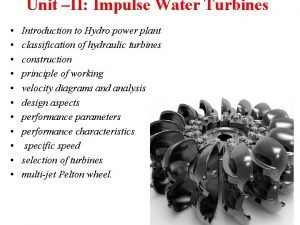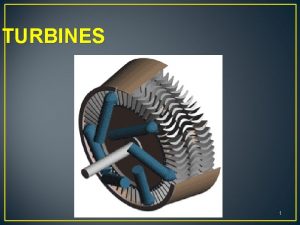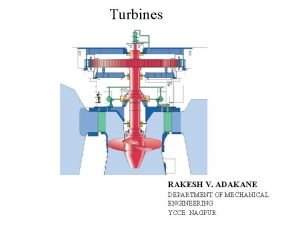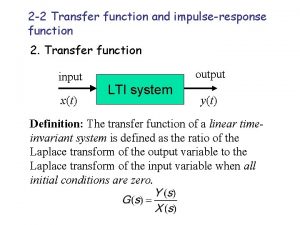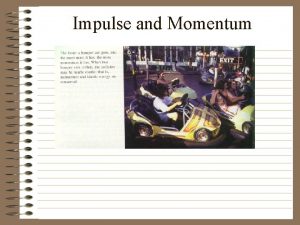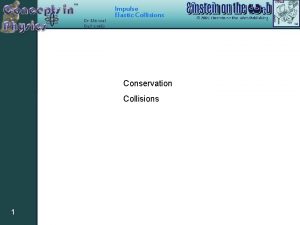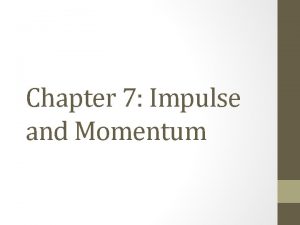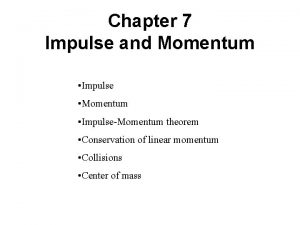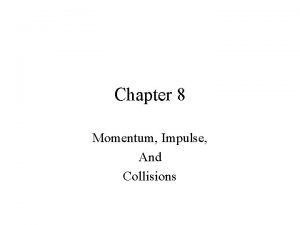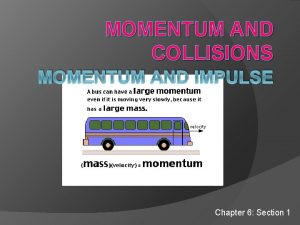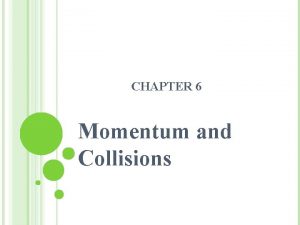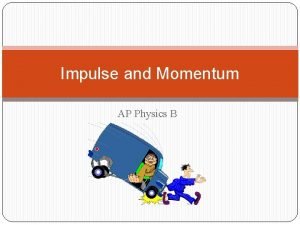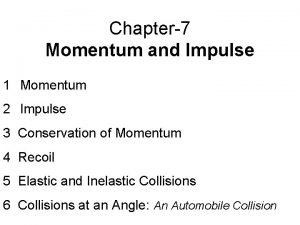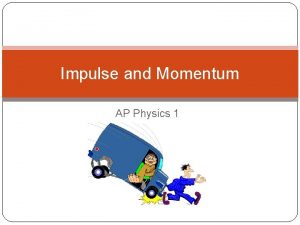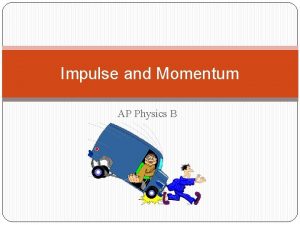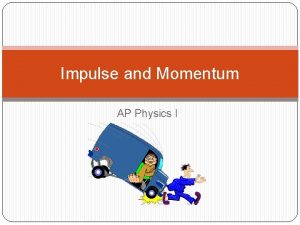Chapter 6 Momentum and Collisions Momentum and Impulse






































































- Slides: 70

Chapter 6 Momentum and Collisions

Momentum and Impulse Objectives: 1. Compare the momentum of different moving objects. 2. Compare the momentum of the same object moving with different velocities. 3. Identify some examples of change in the momentum of an object. 4. Describe changes in momentum in terms of force and time.

Linear Momentum (p) is a quantity defined as the product of the mass and velocity of an object. p = mv momentum = mass x velocity SI units of kg▪m/s The faster an object moves, the more momentum it has and the more difficult it is to stop the object.

Concept Check A deer with a mass of 146 kg is running head-on towards you with a speed of 17 m/s. You are going north. Find the momentum of the deer.

Concept Check 2. 5 x 103 kg▪m/s south

Concept Check A 21 kg child on a 5. 9 kg bike is riding with a velocity of 4. 5 m/s to the northwest. a. What is the total momentum of the child and the bike together? b. What is the momentum of the child? c. What is the momentum of the bike?

Concept Check a. 1. 2 x 102 kg▪m/s northwest b. 94 kg▪m/s northwest c. 27 kg▪m/s northwest

Concept Check What velocity must a 1210 kg car have in order to have a momentum of 5. 6 x 104 kg▪m/s east?

Concept Check 46 m/s east.

Changes in Momentum A change in momentum requires force and time. It requires more force to stop an object with a greater momentum than to stop an object with a smaller momentum. When Newton first expressed his second law, he wrote: F = ∆p ∆t force = change in momentum time interval

Impulse-Momentum Theorem We can rearrange Newton's second law such that F∆t = ∆p or F∆t = ∆p = mvf – mvi force x time interval = change in momentum Thus, a small force acting over a long time can cause the same change in momentum as a large force acting over a short time. Assume all forces are constant unless stated otherwise.

Changes in Momentum ● The expression F∆t is the impulse of the force over the time interval. – The product of the force and the time over which the force acts on an object.

Concept Check A 0. 50 kg football is thrown with a velocity of 15 m/s to the right. A stationary receiver catches the ball and brings it to rest in 0. 020 s. What is the force exerted on the ball by the receiver?

Concept Check 3. 8 x 102 N to the left

Concept Check An 82 kg man drops from rest on a diving board 3. 0 m above the surface of the water and comes to res 0. 55 s after reaching the water. What is the net force on the diver as he is brought to rest?

Concept Check 1. 1 x 103 N upward

Concept Check A 0. 40 kg soccer ball approaches a player horizontally with a velocity of 18 m/s to the north. The player strikes the ball and causes it to move in the opposite direction with a velocity of 22 m/s. What impulse was delivered to the ball by the player?

Concept Check 16 kg▪m/s to the south

Concept Check A 0. 50 kg object is at rest. A 3. 00 N force to the right acts on the object during a time interval of 1. 50 s. a. What is the velocity of the object at the end of this time interval? b. At the end of this interval, a constant force of 4. 00 N to the left is applied for 3. 00 s. What is the velocity at the end of the 3. 00 s?

Concept Check a. 9. 0 m/s to the right. b. 15 m/s to the left.

Stopping Times and Distances Stopping distances and safe following distances are determined using the impulse-momentum theorem Stopping time is determined by solving the impulsemomentum theorem for time. ∆t = ∆ p = mvf-mvi F F Stopping distance can then be determined by the kinematic equation ∆x = ½ (vi + vf)∆t

Concept Check If the maximum coefficient of kinetic friction between a 2300 kg car and a road is 0. 50, what is the minimum stopping distance for a car entering a skid at 29 m/s?

Concept Check 86 m

Concept Check How long would it take a 2240 kg car to come to a full stop from 20. 0 m/s to the west if the force on the car 8410 N to the east? How far would the car go before stopping? Assume a constant acceleration.

Concept Check 5. 33 s; 53. 3 m to the west

Concept Check A 2500 kg car traveling to the north is slowed down uniformly from an initial velocity of 20. 0 m/s by a 6250 N braking force acting opposite the car's motion. Use the impulse-momentum theorem to answer the following questions: a. What is the car's velocity after 2. 50 s? b. How far does the car move during 2. 50 s? c. How long does it take the car to come to a complete stop?

Concept Check a. 14 m/s north b. 42 m north c. 8. 0 s

Concept Check Assume the car in problem 2 has a mass of 3250 kg a. How much force would be required to cause the same acceleration as in item 1? Use the impulsemomentum theorem. b. How far would the car move before stopping?

Concept Check a. 1. 22 x 104 N to the east b. 53. 3 m to the west

More Time = Less Force ● ● ● The impulse-momentum theorem is also used to design safety equipment that reduces the force acting on the human body during collisions. (Nets, air mattresses, air bags, etc. ) When an egg is dropped on the floor, it breaks. When an egg is dropped on a pillow, it doesn't break.

Conservation of Momentum Objectives: 1. Describe the interaction between two objects in terms of the change in momentum of each object. 2. Compare the total momentum of two objects before and after they interact. 3. State the law of conservation of momentum. 4. Predict the final velocities of objects after collisions, given the initial velocities.

Conservation of Momentum is a conserved quantity. When 2 objects collide, the initial momentum is equal in magnitude to the final momentum. m 1 v 1, i + m 2 v 2, i = m 1 v 1, f + m 2 v 2, f For an isolated system, the law of the conservation of momentum can be stated as The total momentum of all objects interacting with one another remains constant regardless of the nature of the forces between the objects.

Collisions ● ● Momentum is conserved in collisions. Consider two billiard balls: one is moving at a constant velocity and the other is at rest. – When the moving ball collides with the nonmoving ball, the moving ball slows down and the ball that was initially at rest begins to move. – The individual momentums of the balls have changed, but the total momentum of the system remains the same (IN THE ABSENCE OF FRICTION!!!). ● In most problems, disregard friction

Moving Apart ● ● ● Conservation of momentum also occurs when objects move away from each other. When you are sitting in your favorite class (Physics of course), your momentum is zero. When the bell rings and you jump up and run like heck to the door, you have momentum, so how is momentum conserved? You have to include the Earth in your analysis of the situation. If you jump up at an initial momentum of 25 kg▪m/s upward

Moving Apart ● The Earth is moving away from you at a momentum of 25 kg▪m/s downward, so the total momentum remains the same (zero).

Concept Check A 63. 0 kg astronaut is on a spacewalk when the tether line to the shuttle breaks. The astronaut is able to throw a spare 10. 0 kg oxygen tank in a direction away from the shuttle with a speed of 12. 0 m/s, propelling the astronaut back to the shuttle. Assuming that the astronaut starts from rest with respect to the shuttle, find the astronaut's final speed with respect to the shuttle after the tank is thrown.

Concept Check 1. 90 m/s

Concept Check An 85. 0 kg fisherman jumps from a dock into a 135. 0 kg rowboat at rest on the west side of the dock. If the velocity of the fisherman is 4. 30 m/s to the west as he leaves the dock, what is the final velocity of the fisherman and the boat?

Concept Check 1. 66 m/s west

Concept Check Each croquet ball in a set has a mass of 0. 50 kg. The green ball, traveling at 12. 0 m/s, strikes the blue ball, which is at rest. Assuming that the balls slide on a frictionless surface and all collisions are head-on, find the final speed of the blue ball in each of the following situations: a. The green ball stops moving after it strikes the blue ball. b. The green ball continues moving after the collision at 2. 4 m/s in the same direction.

Concept Check a. 12. 0 m/s b. 9. 6 m/s

Concept Check A boy on a 2. 0 kg skateboard initially at rest tosses a 8. 0 kg jug of water in the forward direction. If the jug has a speed of 3. 0 m/s relative to the ground and the boy and the skateboard move in the opposite direction at 0. 60 m/s, find the boy's mass

Concept Check 38 kg

Forces In Real Collisions Are Not Constant We treat the forces involved in a collision as though they were constant, but in real-life situations the forces will vary throughout the course of a collision. At any instant during a collision, the forces of the two colliding objects will be equal and opposite. When solving impulse problems, use the average force over the time interval as the value force.

Elastic and Inelastic Collisions Objectives: 1. Identify different types of collisions. 2. Determine the changes in kinetic energy during perfectly inelastic collisions. 3. Compare conservation of momentum and conservation of kinetic energy in perfectly inelastic and elastic collisions. 4. Find the final velocity of an object in perfectly inelastic and elastic collisions.

Perfectly Inelastic Collisions When two objects collide and move together as one after the collision (stick together), the collision is a perfectly inelastic collision. The total momentum of the two objects after the collision is equal to the total momentum of the two objects before the collision. m 1 v 1, i + m 2 v 2, i = (m 1 + m 2)vf


Concept Check A 1500 kg car traveling at 15. 0 m/s to the south collides with a 4500 kg truck that is initially at res at a stoplight. The car and truck stick together and move together after the collision. What is the fina velocity of the two-vehicle mass?

Concept Check 3. 8 m/s to the south

Concept Check A grocery shopper tosses a 9. 0 kg bag of rice into a stationary 18. 0 kg grocery cart. The bag hits the cart with a horizontal speed of 5. 5 m/s toward the front of the cart. What is the final speed of the car and bag?

Concept Check 1. 8 m/s

Concept Check A 1. 50 x 104 kg railroad car moving at 7. 00 m/s to the north collides with and sticks to another railroad car of the same mass that is moving in the same direction at 1. 50 m/s. What is the velocity o the joined cars after the collision?

Concept Check 4. 25 m/s to the north

Concept Check A dry cleaner throws a 22 kg bag of laundry onto a stationary 9. 0 kg cart. The cart and laundry bag begins moving at 3. 0 m/s to the right. Find the velocity of the laundry bag before the collision.

Concept Check 4. 2 m/s to the right

Concept Check A 47. 4 kg student runs down the sidewalk and jumps with a horizontal speed of 4. 20 m/s onto a stationary skateboard. The student and skateboard move down the sidewalk with a speed of 3. 95 m/s Find the following: a. the mass of the skateboard b. how fast the student would have to jump to have a final speed of 5. 00 m/s.

Concept Check 3. 00 kg 5. 32 m/s

Kinetic Energy Kinetic energy is not conserved in inelastic collisions. Some of the kinetic energy is converted to sound energy and internal energy as objects are deformed during the collision. The decrease in kinetic energy can be calculated by using the formula for kinetic energy.

Concept Check A 0. 25 kg arrow with a velocity of 12 m/s to the west strikes and pierces the center of a 6. 8 kg targe a. What is the final velocity of the combined mass? b. What is the decrease in kinetic energy during the collision?

Concept Check a. 0. 43 m/s to the west b. 17 J

Concept Check During practice, a student kicks a 0. 40 kg soccer ball with a velocity of 8. 5 m/s to the south into a 0. 15 kg bucket lying on its side. The bucket travels with the ball after the collision. a. What is the final velocity of the combined mass? b. What is the decrease in kinetic energy during the collision?

Concept Check a. 6. 2 m/s to the south b. 3 J

Concept Check A 56 kg ice skater travels at 4. 0 m/s to the north meets and joins hands with a 65 kg skater traveling at 12. 0 m/s in the opposite direction. Without rotating, the two skaters continue skating together with joined hands. a. What is the final velocity of the two skaters? b. What is the decrease in kinetic energy during the collision?

Concept Check a. 4. 6 m/s to the south b. 3. 9 x 103 J

Elastic Collisions ● ● ● In an elastic collision two objects collide and return to thei original shapes with no loss of kinetic energy (they don't stick together. ) – Both momentum and kinetic energy are conserved. In the real world, most collisions are not perfectly inelastic o elastic but somewhere in between. We consider all collisions in which the objects do not stick together to be elastic.

Elastic Collisions The total momentum is always constant throughout the collision. The total kinetic energy is also conserved. m 1 v 1, i +m 2 v 2, i = m 1 v 1, f + m 2 v 2. f ½ m 1 v 1, i 2 + ½ m 2 v 2, i 2 = ½ m 1 v 1, f 2+ ½ m 2 v 2, f 2

Concept Check A 0. 015 kg marble sliding to the right at 22. 5 cm/s on a frictionless surface makes an elastic head-on collision with a 0. 015 kg marble moving to the lef at 18. 0 cm/s. After the collision, the first marble moves to the left at 18. 0 cm/s. a. Find the velocity of the second marble after the collision. b. Verify your answer by calculating the total kinetic energy before and after the collision.

Concept Check a. 22. 5 cm/s to the right b. KEi = 6. 2 x 10 -4 J = KEf

Concept Check A 16. 0 kg canoe moving to the left at 12. 5 m/s makes an elastic head-on collision with a 14. 0 kg raft moving to the right at 16. 0 m/s. After the collision, the raft moves to the left at 14. 4 m/s. Disregard any effects of the water. a. Find the velocity of the canoe after the collision. b. Verify your answer by calculating the total kinetic energy before and after the collision.

Concept Check a. 14. 1 m/s to the right b. 3. 04 x 103 J
 Chapter 6 momentum
Chapter 6 momentum Aplusphysics momentum-conservation answer key
Aplusphysics momentum-conservation answer key A small marble collides with a billiard ball
A small marble collides with a billiard ball A roller coaster climbs up a hill at 4m/s and then zips
A roller coaster climbs up a hill at 4m/s and then zips Whats linear momentum
Whats linear momentum Momentum is conserved in all collisions
Momentum is conserved in all collisions Work energy theorem
Work energy theorem Unit 6 momentum and impulse
Unit 6 momentum and impulse Unit of momentum and impulse
Unit of momentum and impulse Momentum in basketball physics
Momentum in basketball physics Principle of linear impulse and momentum
Principle of linear impulse and momentum How to find maximum compression of a spring formula
How to find maximum compression of a spring formula The importance of momentum
The importance of momentum Poem about momentum and impulse
Poem about momentum and impulse A 2250 kg car traveling to the west slows down
A 2250 kg car traveling to the west slows down Importance of momentum and impulse
Importance of momentum and impulse Momentum and impulse formula sheet
Momentum and impulse formula sheet Momentum s.i unit
Momentum s.i unit Units momentum
Units momentum Momentum units
Momentum units Physics 30 worksheet # 1 momentum
Physics 30 worksheet # 1 momentum The momentum of an object at rest
The momentum of an object at rest Mel physics
Mel physics Si unit of momentum
Si unit of momentum What has momentum
What has momentum Law of impulse
Law of impulse Examples of impulse in physics
Examples of impulse in physics The drawing shows a collision between two pucks
The drawing shows a collision between two pucks Kinetics of a particle: impulse and momentum
Kinetics of a particle: impulse and momentum Unit 5 momentum 5.a center of mass
Unit 5 momentum 5.a center of mass Dynamics impulse and momentum solved problems
Dynamics impulse and momentum solved problems Principle of angular impulse and momentum
Principle of angular impulse and momentum Ap physics momentum and impulse
Ap physics momentum and impulse Further mechanics 1 unit test 1 momentum and impulse
Further mechanics 1 unit test 1 momentum and impulse Physics collision
Physics collision Change in momentum formula
Change in momentum formula Kinetic energy in terms of linear momentum
Kinetic energy in terms of linear momentum How does impulse relate to momentum
How does impulse relate to momentum The impulse-momentum relationship is a direct result of
The impulse-momentum relationship is a direct result of Center of mass equations
Center of mass equations Impulse momentum bar chart
Impulse momentum bar chart Impulse response laplace
Impulse response laplace Angular momentum theorem
Angular momentum theorem Momentum
Momentum Impulse momentum
Impulse momentum Impulse momentum theorem definition
Impulse momentum theorem definition Rhonda who has a mass of 60kg
Rhonda who has a mass of 60kg Impulse momentum theorem egg drop
Impulse momentum theorem egg drop Karate blow
Karate blow Momentum bar chart
Momentum bar chart The impulse-momentum relationship is a direct result of
The impulse-momentum relationship is a direct result of Conceptual physics momentum
Conceptual physics momentum Elastic vs inelastic collision
Elastic vs inelastic collision Collisions and explosions
Collisions and explosions Collisions
Collisions Loss of energy in collision
Loss of energy in collision To avoid collisions a defensive driver should
To avoid collisions a defensive driver should Perfect inelastic collision
Perfect inelastic collision Collision theory diagrams
Collision theory diagrams Inelastic collision examples real world
Inelastic collision examples real world Difference between elastic and inelastic collision
Difference between elastic and inelastic collision When you move into the deceleration lane, you should
When you move into the deceleration lane, you should Success of classical free electron theory
Success of classical free electron theory Mean free path formula
Mean free path formula To avoid collisions a defensive driver should
To avoid collisions a defensive driver should Prévention des collisions engins-piétons
Prévention des collisions engins-piétons Collisions
Collisions Difference of impulse and reaction turbine
Difference of impulse and reaction turbine Impulse and reaction turbine difference
Impulse and reaction turbine difference Adakane in english
Adakane in english H(s) transfer function
H(s) transfer function
